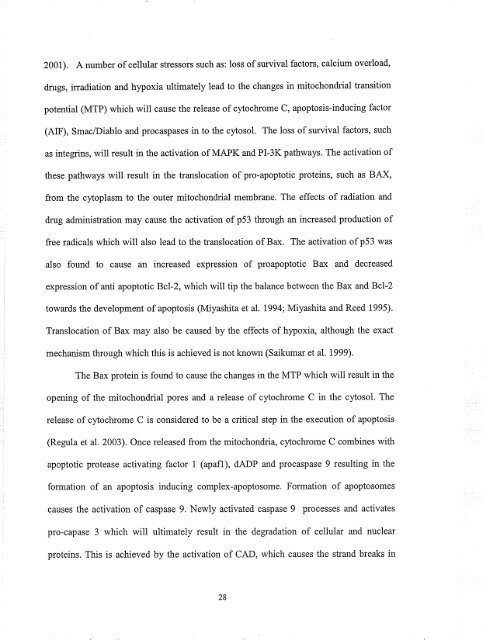il\VOLVEMENT OF RETII\OIC ACID II{ - MSpace at the University of ...
il\VOLVEMENT OF RETII\OIC ACID II{ - MSpace at the University of ...
il\VOLVEMENT OF RETII\OIC ACID II{ - MSpace at the University of ...
Create successful ePaper yourself
Turn your PDF publications into a flip-book with our unique Google optimized e-Paper software.
2001). A number <strong>of</strong> cellular stressors such as: loss <strong>of</strong> survival factors, calcium overload,<br />
drugs, irradi<strong>at</strong>ion and hypoxia ultim<strong>at</strong>ely lead to <strong>the</strong> changes in mitochondrial transition<br />
potential (MTP) which will cause <strong>the</strong> release <strong>of</strong> cytochrome C, apoptosis-inducing factor<br />
(AIF), SmaclDiablo and procaspases in to <strong>the</strong> cytosol. The loss <strong>of</strong> survival factors, such<br />
as integrins, will result in <strong>the</strong> activ<strong>at</strong>ion <strong>of</strong> MAPK and PI-3K p<strong>at</strong>hways. The activ<strong>at</strong>ion <strong>of</strong><br />
<strong>the</strong>se p<strong>at</strong>hways will result in <strong>the</strong> transloc<strong>at</strong>ion <strong>of</strong> pro-apoptotic proteins, such as BAX,<br />
from <strong>the</strong> cytoplasm to <strong>the</strong> outer mitochondrial membrane. The effects <strong>of</strong> radi<strong>at</strong>ion and<br />
drug administr<strong>at</strong>ion may cause <strong>the</strong> activ<strong>at</strong>ion <strong>of</strong> p53 through an increased production <strong>of</strong><br />
free radicals which will also lead to <strong>the</strong> transloc<strong>at</strong>ion <strong>of</strong> Bax. The activ<strong>at</strong>ion <strong>of</strong> p53 was<br />
also found to cause an increased expression <strong>of</strong> proapoptotic Bax and decreased<br />
expression <strong>of</strong> anti apoptotic Bcl-2, which will tip <strong>the</strong> balance between <strong>the</strong> Bax and Bcl-2<br />
towards <strong>the</strong> development <strong>of</strong> apoptosis (Miyashita et al. 1994; Miyashita and Reed 1995).<br />
Transloc<strong>at</strong>ion <strong>of</strong> Bax may also be caused by <strong>the</strong> effects <strong>of</strong> hypoxia, although <strong>the</strong> exact<br />
mechanism through which this is achieved is not known (Saikumar et aI.1999).<br />
The Bax protein is found to cause <strong>the</strong> changes in <strong>the</strong> MTP which will result in <strong>the</strong><br />
opening <strong>of</strong> <strong>the</strong> mitochondrial pores and a release <strong>of</strong> cytochrome C in <strong>the</strong> cytosol. The<br />
release <strong>of</strong> cytochrome C is considered to be a critical step in <strong>the</strong> execution <strong>of</strong> apoptosis<br />
(Regula et al. 2003). Once released from <strong>the</strong> mitochondria, cytochrome C combines with<br />
apoptotic protease activ<strong>at</strong>ing factor I (apafl), dADP and procaspase 9 resulting in <strong>the</strong><br />
form<strong>at</strong>ion <strong>of</strong> an apoptosis inducing complex-apoptosome. Form<strong>at</strong>ion <strong>of</strong> apoptosomes<br />
causes <strong>the</strong> activ<strong>at</strong>ion <strong>of</strong> caspase 9. Newly activ<strong>at</strong>ed caspase 9 processes and activ<strong>at</strong>es<br />
pro-capase 3 which will ultim<strong>at</strong>ely result in <strong>the</strong> degrad<strong>at</strong>ion <strong>of</strong> cellular and nuclear<br />
proteins. This is achieved by <strong>the</strong> activ<strong>at</strong>ion <strong>of</strong> CAD, which causes <strong>the</strong> strand breaks in<br />
28







![an unusual bacterial isolate from in partial fulf]lment for the ... - MSpace](https://img.yumpu.com/21942008/1/190x245/an-unusual-bacterial-isolate-from-in-partial-fulflment-for-the-mspace.jpg?quality=85)





![in partial fulfil]ment of the - MSpace - University of Manitoba](https://img.yumpu.com/21941988/1/190x245/in-partial-fulfilment-of-the-mspace-university-of-manitoba.jpg?quality=85)


